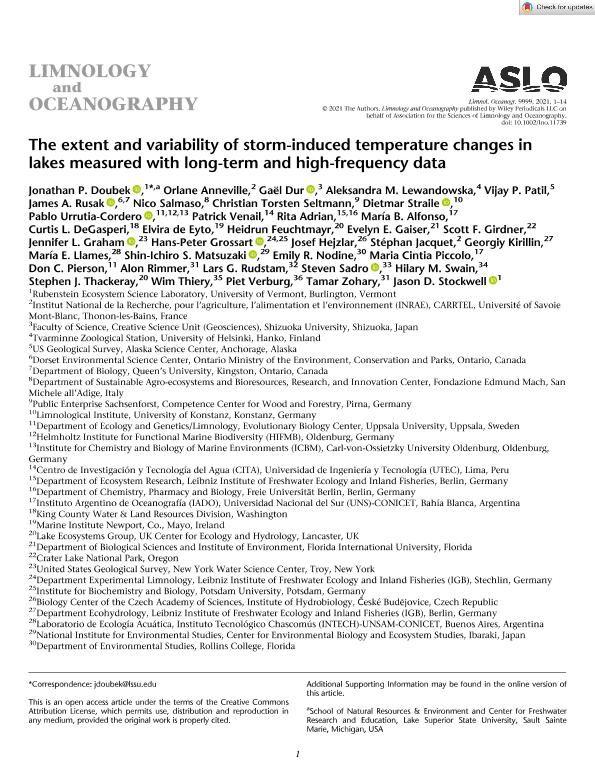Artículo
The extent and variability of storm‐induced temperature changes in lakes measured with long‐term and high‐frequency data
Doubek, Jonathan P.; Anneville, Orlane; Dur, Gaël; Lewandowska, Aleksandra M.; Patil, Vijay P.; Rusak, James A.; Salmaso, Nico; Torsten Seltmann, Christian; Straile, Dietmar; Urrutia Cordero, Pablo; Venail, Patrick; Adrian, Rita; Alfonso, María Belén ; DeGasperi, Curtis L.; Eyto, Elvira; Feuchtmayr, Heidrun; Gaiser, Evelyn E.; Girdner, Scott F.; Graham, Jennifer L.; Grossart, Hans-peter; Hejzlar, Josef; Jacquet, Stéphan; Kirillin, Georgiy; Llames, Maria Eugenia del Rosario
; DeGasperi, Curtis L.; Eyto, Elvira; Feuchtmayr, Heidrun; Gaiser, Evelyn E.; Girdner, Scott F.; Graham, Jennifer L.; Grossart, Hans-peter; Hejzlar, Josef; Jacquet, Stéphan; Kirillin, Georgiy; Llames, Maria Eugenia del Rosario ; Matsuzaki, Shin Ichiro S.; Nodine, Emily R.; Piccolo, Maria Cintia
; Matsuzaki, Shin Ichiro S.; Nodine, Emily R.; Piccolo, Maria Cintia ; Pierson, Don C.; Rimmer, Alon; Rudstam, Lars G.; Sadro, Steven; Swain, Hilary M.; Thackeray, Stephen J.; Thiery, Wim; Verburg, Piet; Zohary, Tamar; Stockwell, Jason D.
; Pierson, Don C.; Rimmer, Alon; Rudstam, Lars G.; Sadro, Steven; Swain, Hilary M.; Thackeray, Stephen J.; Thiery, Wim; Verburg, Piet; Zohary, Tamar; Stockwell, Jason D.
 ; DeGasperi, Curtis L.; Eyto, Elvira; Feuchtmayr, Heidrun; Gaiser, Evelyn E.; Girdner, Scott F.; Graham, Jennifer L.; Grossart, Hans-peter; Hejzlar, Josef; Jacquet, Stéphan; Kirillin, Georgiy; Llames, Maria Eugenia del Rosario
; DeGasperi, Curtis L.; Eyto, Elvira; Feuchtmayr, Heidrun; Gaiser, Evelyn E.; Girdner, Scott F.; Graham, Jennifer L.; Grossart, Hans-peter; Hejzlar, Josef; Jacquet, Stéphan; Kirillin, Georgiy; Llames, Maria Eugenia del Rosario ; Matsuzaki, Shin Ichiro S.; Nodine, Emily R.; Piccolo, Maria Cintia
; Matsuzaki, Shin Ichiro S.; Nodine, Emily R.; Piccolo, Maria Cintia ; Pierson, Don C.; Rimmer, Alon; Rudstam, Lars G.; Sadro, Steven; Swain, Hilary M.; Thackeray, Stephen J.; Thiery, Wim; Verburg, Piet; Zohary, Tamar; Stockwell, Jason D.
; Pierson, Don C.; Rimmer, Alon; Rudstam, Lars G.; Sadro, Steven; Swain, Hilary M.; Thackeray, Stephen J.; Thiery, Wim; Verburg, Piet; Zohary, Tamar; Stockwell, Jason D.
Fecha de publicación:
04/2021
Editorial:
American Society of Limnology and Oceanography
Revista:
Limnology and Oceanography
ISSN:
0024-3590
Idioma:
Inglés
Tipo de recurso:
Artículo publicado
Clasificación temática:
Resumen
The intensity and frequency of storms are projected to increase in many regions of the world because of climate change. Storms can alter environmental conditions in many ecosystems. In lakes and reservoirs, storms can reduce epilimnetic temperatures from wind-induced mixing with colder hypolimnetic waters, direct precipitation to the lake?s surface, and watershed runoff. We analyzed 18 long-term and high-frequency lake datasets from 11 countries to assess the magnitude of wind- vs. rainstorm-induced changes in epilimnetic temperature. We found small day-to-day epilimnetic temperature decreases in response to strong wind and heavy rain duringstratified conditions. Day-to-day epilimnetic temperature decreased, on average, by 0.28C during the strongest windstorms (storm mean daily wind speed among lakes: 6.7 2.7 m s−1, 1 SD) and by 0.15C after the heaviest rainstorms (storm mean daily rainfall: 21.3 9.0 mm). The largest decreases in epilimnetic temperature were observed ≥2 d after sustained strong wind or heavy rain (top 5th percentile of wind and rain events for each lake) in shallow and medium-depth lakes. The smallest decreases occurred in deep lakes. Epilimnetic temperature change from windstorms, but not rainstorms, was negatively correlated with maximum lake depth. However, even the largest storm-induced mean epilimnetic temperature decreases were typically <2C. Day-to-day temperaturechange, in the absence of storms, often exceeded storm-induced temperature changes. Because storm-induced temperature changes to lake surface waters were minimal, changes in other limnological variables (e.g., nutrient concentrations or light) from storms may have larger impacts on biological communities than temperature changes.
Palabras clave:
LAKES
,
TEMPERATURE
,
HIGH-FREQUENCY
Archivos asociados
Licencia
Identificadores
Colecciones
Articulos(IADO)
Articulos de INST.ARG.DE OCEANOGRAFIA (I)
Articulos de INST.ARG.DE OCEANOGRAFIA (I)
Articulos(IIB-INTECH)
Articulos de INST.DE INVEST.BIOTECNOLOGICAS - INSTITUTO TECNOLOGICO CHASCOMUS
Articulos de INST.DE INVEST.BIOTECNOLOGICAS - INSTITUTO TECNOLOGICO CHASCOMUS
Citación
Doubek, Jonathan P.; Anneville, Orlane; Dur, Gaël; Lewandowska, Aleksandra M.; Patil, Vijay P.; et al.; The extent and variability of storm‐induced temperature changes in lakes measured with long‐term and high‐frequency data; American Society of Limnology and Oceanography; Limnology and Oceanography; 9999; 4-2021; 1-14
Compartir
Altmétricas



